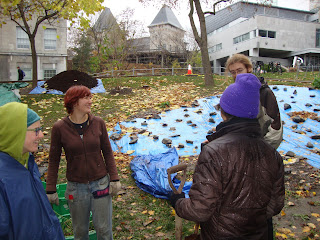Welly welly welly welly well, seems like fall has arrived. Time to close the garden! Which is exactly what Campus Crops did on November 3.
 |
What a nice team! ...and Carl, too, over there.
|
Closing the garden is a quite crucial step, as the way it is done will determine the quality and compaction of the soil when spring comes. There are also some things that can done at that time if one wants to reduce the risks of diseases for the following growing season. A basic routine for putting a garden to bed consists of about 5 simple steps, namely: (1) uprooting all annuals, (2) cutting back all perennials, (3) amending the soil, (4) mulching the whole thing, and (5) a general clean up of the area (tools, bags of soil, various structures left there).
That's pretty much what we did, but since the soil in our garden is very clayish, we thought we could do a little more to improve it a bit. Clayish soil is, you probably guessed it, a soil that is characterized by a large proportion of clay, compared to the respective proportions of organic matter and sand. Clayish soil drains poorly. This means that it takes quite a long time for water to percolate deep into the soil, which increases the risks of shallow watering and all the bad things that come with it. The converse of draining poorly is retaining water well, so it's easier for the soil to get water-logged and for the plant roots to rot if they sit in water for too long. Clayish soil also cracks and crusts easily when it dries, and, clay being clay, compacts a lot if it's walked too much a lot or if it gets too dry.
All this amounts to a lot of extra care toward the soil in an environment that is already not so optimal. In order to improve clayish soil, a common method is to mix a lot of organic material into the first 6 inches or so of soil. This increases the proportion of organic matter, and brings the composition closer to that of loam (a well-balanced soil). We could have added sand too, but organic matter enriches the soil, while sand is, well, sand.
It is also possible to improve clayish soil during the growing season with minimal inputs (i.e. instead of hauling half a dozen cubic yards of mulch and compost to the garden): tubers (e.g. potatoes), root vegetables (e.g. carrots) and cover crops with deep taproots (e.g. rye) can be planted. They will break up the soil as they grow, leach nutrients from the deep layers up to the surface and leave some organic matter (their roots) to rot in the soil. That's actually the 'permaculture-approved' method, but it takes a lot of time and effort, and can also demand some sacrifice, like growing nothing but rye for a year because root vegetables and tubers don't grow well in a soil that is too clayish (we had such problems with our root vegetables last year).
Anyway, we decided to get some mulch and compost and turn it into the soil. We got half the compost we used from the city of Montreal and the rest came from Big Hanna, the hot-compost machine on downtown campus.
 |
| Getting compost at the city give-away: "Maaaaah!" |
Let's focus back on the action. Our plan was quite simple:
1) Arrive at the garden at 1pm.
2) Uproot all annuals.
3) Cut back the few perennials we have (rhubarb, chives and blackberries) and transfer them in pots while we do the rest.
4) Turn, break and level the soil over all the garden.
5) Add a 3-inch layer of mulch and the compost we had.
6) Mix that layer with the turned soil underneath.
7) Cover the whole area with dead leaves in order to avoid extra compaction from the weight of the snow and ice.
8) Call it a day and go eat some vegan chili.
 |
| Let's plan shits! We need people, smiles and BLUE TARPS! |
Everything went quite well, aside from the fact that it rained daily during the previous week. Needless to say, the soil was heavy and sticky, though the rain seemed to have softened it a bit. Some lovely and courageous people took a few hours of their day to come and help us; we reached a peak of 9 people around 4pm. It also seemed like we ordered too much mulch, so we couldn't really mix it into the soil because the layer was too thick. Hopefully we'll have a much nicer soil next spring anyway!
Now that we're totally done with gardening until next year, Campus Crops will continue to host various workshops and film screenings throughout the winter. There will be one every month or so. Stay up to date by checking our blog, subscribing to our listserv or sending an email to campuscrops@gmail.com. You can also send us any idea of film you'd like us to screen, or workshop or event you'd like us to host! We also have weekly meetings every Tuesdays at 5pm in the MUGS Lounge (Burnside, room 305) during which we plan and organize said workshops.
I've said enough, here are more pictures!
 |
| Clay, mud and short shovels |
 |
| "Turning the soil: check! Now we just need to add the mulch and the compost, turn everything into the soil and put some dead leaves over the whole thing. We should be done soon!" |
Resources for putting the garden to bed:
5 steps to putting your vegetable garden to bed
Putting Your Garden to Bed; Your Best Move for Spring


No comments:
Post a Comment